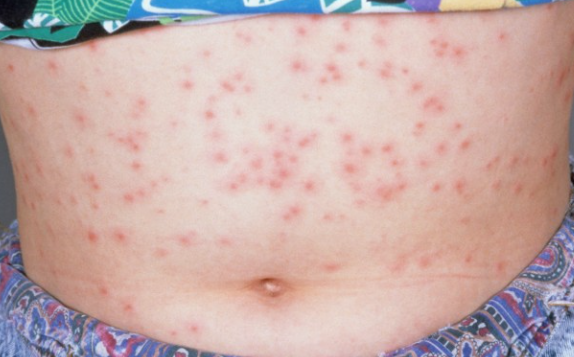Pseudomonas folliculitis is an acute skin infection that affects hair follicles, and develops after exposure to water contaminated with various types of Pseudomonas bacteria. ICD-10 code is B96.5.
Children are affected much more often than adults, probably because children spend more time in water. Pseudomonas folliculitis typically occurs within a period of 8 hours to 5 days (usually within a day) after exposure to a contaminated pool (whirlpool, hot tub, spa, therapeutic pool) or use of water attractions. The incidence of illness varies, with 7-100% of people exposed to Pseudomonas species potentially developing the disease.
Person-to-person transmission is unlikely. Prolonged exposure to water, high numbers of bathers, and poor pool hygiene predispose individuals to infection. Shed skin cells in the water provide a rich organic food source for the bacteria. Compression and overhydration of the outermost layer of the skin (stratum corneum) promote Pseudomonas aeruginosa colonization of the skin. Women who wear close-fitting swimsuits are at higher risk.The lesions are typically 0.5 to 3 cm in size, urticarial in appearance, pruritic, round, red in color, with a papule or pustule in the center. There may be a primary eruption of several to 50 of these lesions on the trunk. The eruptions may be follicular, maculopapular, vesicular, pustular, or polymorphic, including all of the above.
They are most common on the trunk, buttocks, groin, and extremities. The most severe eruptions occur in areas where tight-fitting swimsuits have compressed the skin. Eruptions may also occur on the soles of the feet, palms of the hands, face, and genitals. High fever, malaise, and fatigue may be present during the first few days of the eruption, but these symptoms are not typical.
In most cases, the eruptions clear within 7-10 days, leaving round reddish-brown patches of post-inflammatory hyperpigmentation without treatment. However, eruptions may recur for up to 3 months.- Bacterial folliculitis
- Malassezia folliculitis
- Eosinophilic folliculitis
- Acne
- Swimmer's Itch
- Viral Infections - Herpes Simplex, Chickenpox, Molluscum Contagiosum
- Urticaria
- Insect Bites
The infection usually clears up on its own and treatment is usually not needed.
Wet compresses with 5% acetic acid are applied 2-4 times a day for 20 minutes. Creams and ointments containing silver sulfadiazine or gentamicin may be prescribed. In cases resistant to topical therapy, oral ciprofloxacin at a dose of 500 mg or 750 mg twice daily for 5-10 days may be prescribed.
Preventive measures:
Continuous water filtration helps to remove shed skin scales. Adequate water chlorination should be maintained.
Sponges and loofahs should be thoroughly dried between uses.
Public hot tubs should be drained daily.
Showering after exposure to contaminated water is not a protective measure.
